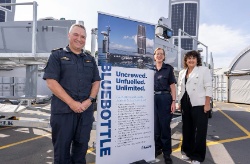Catlins TB control also protects native birds and forest
TBfree CMYK
Media release
27 August 2013
Catlins TB control also protects native birds and forest
TBfree New Zealand will begin a joint possum
control operation in the Catlins area across privately-owned
and public conservation land to protect farmed cattle and
deer from bovine tuberculosis (TB).
The Catlins aerial operation will control bovine TB in wild animals and enhance biodiversity through collaboration with the Department of Conservation (DOC) to remove introduced pests that prey on native wildlife.
As a result of combining resources, this joint operation, using biodegradable 1080, has meant urgent action can be taken to control an exploding rat population threatening the endangered native mohua (yellowhead).
The aerial operation will cover some 38,000 hectares and supports large-scale annual ground-based control in the area, using traps and hand-laid toxins. The operation is due to start this month, depending on the weather.
Over the coming year, TBfree New Zealand plans to control the disease in possum populations over about 1.45 million hectares of South Canterbury, Otago and Southland. Ground control methods form the majority of this work, covering some 1.4 million hectares.
TBfree New Zealand aims to eradicate the disease from around one million hectares of the Southern South Island by 2026, as part of the national TB control plan.
TBfree Otago Committee Chairman Ross Beckingsale said the Catlins control operation aimed to keep possum numbers low to minimise the risk of TB spreading to nearby cattle and deer herds.
“It is important that we protect the investment and effort put into controlling TB in the area. We can’t afford to lose the gains that have been made as we work towards eradicating TB from wild animal populations,” said Mr Beckingsale.
TBfree New Zealand Southern South Island Programme Manager Brent Rohloff said strict regulations must be followed when undertaking possum control operations.
“This includes consent from various organisations, consultation with affected land occupiers and the placement of warning signs at each main access point to the operational area,” said Mr Rohloff.
The warning signs clearly state what toxin has been used, and that the area is out of bounds for pets, especially dogs, until the signs have been officially removed.
-ends-


 Gordon Campbell: On The Left’s Electability Crisis, And The Abundance Ecotopia
Gordon Campbell: On The Left’s Electability Crisis, And The Abundance Ecotopia Regional and Unitary Councils Aotearoa: Regional And Unitary Councils Back A Practical FWFP System
Regional and Unitary Councils Aotearoa: Regional And Unitary Councils Back A Practical FWFP System NZ Government: Stay Safe On Our Roads This Easter
NZ Government: Stay Safe On Our Roads This Easter YWCA: Global Push Back Against Gender Equality A Growing Crisis In Aotearoa
YWCA: Global Push Back Against Gender Equality A Growing Crisis In Aotearoa Te Pāti Māori: Ngarewa-Packer - Fast-Tracking Seabed Mining Ignores Māori Opposition And Environmental Precedent
Te Pāti Māori: Ngarewa-Packer - Fast-Tracking Seabed Mining Ignores Māori Opposition And Environmental Precedent New Zealand Defence Force: Defence And Customs Strengthen Maritime Security With Uncrewed Surface Vessels
New Zealand Defence Force: Defence And Customs Strengthen Maritime Security With Uncrewed Surface Vessels SPCA: Huge Win With New Dog Tethering Regulations
SPCA: Huge Win With New Dog Tethering Regulations


